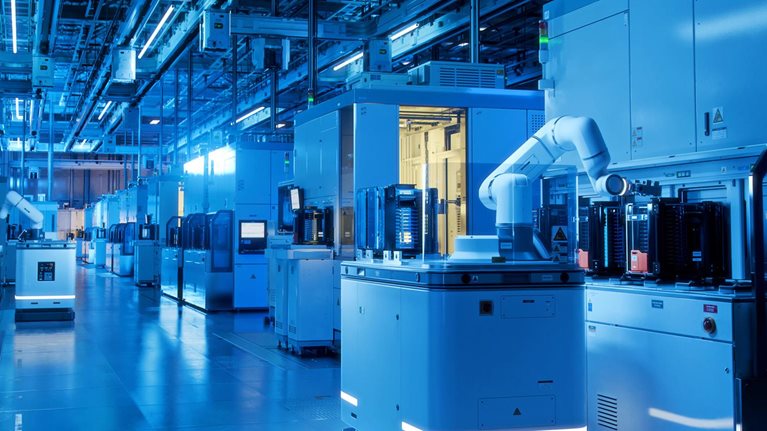The supply of semiconductors has been, and remains, a significant challenge for industries around the world. Manufacturers in sectors such as automotive, consumer goods, and technology have been hit with shortages that held back production and put profits at risk. But some chief operating officers are building resilience into their supply chains by turning to artificial-intelligence-based solutions, which give them near-real-time insights into pricing and demand fluctuations.
The reasons for these semiconductor bottlenecks include limited capacity, high demand, and overordering—which means that they are likely to persist through 2023, McKinsey analysis shows (Exhibit 1). The most extreme pressure will be on mature chips for everyday applications, such as cars, electronics, home appliances, and medical devices. Growth in manufacturing capacity is set to remain patchy until at least 2026. Smaller node capacities are set to expand fastest: seven-nanometer capacity is predicted to grow at a CAGR of 14 percent annually, 100-nanometer capacity at 4 percent. Varying levels of production reflect wider industry dynamics. Some companies want to add capacity: Taiwanese chipmaker TSMC, for example, plans to spend $32 billion to $36 billion in 2023 alone, despite expectations of softer demand. Other companies—both integrated device manufacturers (IDM) and foundries—are operating close to or at full utilization.1

At the time of writing, some recent bottlenecks, including those stemming from the impact of COVID-19 in Asia and spikes in demand—have abated. Prices are therefore lower in some subcategories. Memory prices, for example, are expected to go on falling in the first half of 2023, after the market collapsed in the second half of 2022. If the recent past is any indication, however, supply challenges will remain high on C-suite agendas. Indeed, given a seeming new normal of geopolitical instability, the most likely scenario would involve waves of supply-and-demand mismatches across chips sizes, industries, and production centers.
Manufacturers need certainty of supply and must identify and onboard new suppliers rapidly. Continuing supply constraints present a significant challenge. Furthermore, many companies are constrained by limited procurement setups that focus on just a few suppliers and distributors and miss many others. The good news is that a way to speed up the discovery of suppliers is emerging: a new generation of tools that pair human expertise with artificial intelligence (AI) to radically streamline the supplier identification process. By moving away from manual approaches, teams can scan hundreds of proprietary, public-source, and commercial databases simultaneously—helping them to obtain the right chips in a fraction of the time formerly required.
Supply-and-demand mismatches
Global semiconductor capacity grew at 7.6 percent a year on average from 2015 to 2022, but the growth is forecast to slow down to 4.9 percent a year from 2022 to 2026. Amid global macroeconomic headwinds, semiconductor industry revenues are predicted to fall by 3 to 4 percent in 2023. The biggest short-term capacity upgrades will take place in the Greater China area, including Taiwan. Elsewhere, new fabs in recently announced investments will take several years to come on line.
The underlying supply of specific chips is equally bumpy. Semiconductor devices such as microcontrollers and sensors currently have lead times of 20 to 40 weeks, while some others, such as CPUs and DRAMs, are in surplus. Indeed, the DRAM market is expected to be in oversupply during the first three quarters of 2023 as a result of dampened production of consumer electronics, PCs, and smartphones. Lead times peaked at 22 weeks in mid-2022 but were down to 19 weeks in early 2023.2
A McKinsey analysis of semiconductor shortages since April 2022 shows that about 90 percent of the shortage-driven demand is associated with mature technologies.3 The same analysis showed that about 75 percent of all shortage-driven demand involves integrated circuits, such as voltage regulators, which represent about 66 percent of demand, and discrete semiconductors, such as MOSFETS, which represent about 10 percent of it (Exhibit 2).

In the short term, the demand dynamics will remain volatile. We already see a shift from shortages to oversupply in some segments in early 2023. The weak economic outlook and declining production of consumer electronics, PCs, and smartphones, for example, are creating excess stocks of DRAMs, NANDs, and other memory chips. By contrast, sectors such as industrial and automotive are likely to face continuing tightness of supply, both in the short and medium terms, given predicted growth in demand of 10 percent and 14 percent (CAGR), respectively (Exhibit 3). This tightness will reflect both the macroenvironment and long-term trends, such as the switch to battery electric vehicles.

Looking further ahead, McKinsey analysis shows that demand for semiconductors is set to rise by 6 to 7 percent a year up to 2030. Most of the pressure will be on mature, feature-rich integrated circuits and discrete devices.
Manufacturers are firefighting
Faced with shortages, most manufacturers have adopted a strategy of firefighting: tapping into pockets of supply when and where they can. Finding reliable suppliers is easier said than done, however, and many companies struggle to secure partners, consistent flows, or both. Fast-growing sectors and high-demand companies face some of the biggest hurdles, but the problem is pervasive across industries. Our analysis suggests that more than 80 percent of end-user companies are ill-equipped to tackle chip shortages.
To fill gaps, many companies make ad hoc purchases, usually working with specialized, independent, or franchised distributors and sometimes setting up internal teams. These efforts mitigate immediate pressures on supply but don’t resolve common structural weaknesses in the procurement process. These include a failure to move away from business-as-usual practices, inadequate organizational setups, and missing talent.
One pervasive challenge is that only a few OEMs own all their manufacturing facilities. This issue creates a dependence on tier-one suppliers, such as electronics-manufacturing services (EMSs), contract manufacturers, and original design manufacturers. In addition, end users often are not set up to receive and manage chip inventory themselves and do not have the processes to execute buy–sell transactions with an EMS.
Chip hunting to alleviate short-term bottlenecks
Given the pressures that chip shortages exert on short-term performance, companies need bold and speedy solutions. The experience of forward-looking companies suggests that the optimal approach combines short-term expediency with a strategic focus on the medium and longer terms.
In the short term, a technical chip-hunting strategy would involve a more systematic approach to scanning for supply in the open market. Here, AI can make a difference by helping companies to cast wider nets for new suppliers and stock. Companies that have used AI report unlocking multiple new sources, even for customized parts. Sometimes there is a price to pay—in budgets, testing, and even quality—but the upside in capacity more than offsets the costs.
Machine learning algorithms should be combined with a top-down review of priorities. It may be best, for example, to focus on alleviating shortages that put revenues or high-margin products at risk. In addition, companies can tailor their approaches to current and projected needs, as well the inevitable trade-offs. In the short term, it may be possible to redesign critical parts, to adjust demand dynamics (for example through active configuration steering), and to adopt an EBIT-based allocation strategy.
One potential pitfall in seeking short-term supply is chip quality. The challenge of avoiding counterfeit parts is perennial. To reduce the risk, some players are working with specialized services that have expertise in vetting suppliers and running detailed tests. An AI approach can also help companies identify alternative and more widely available chips.
Looking to the longer term
As companies scan the market to meet their short-term needs, the elephant in the room is the medium and longer terms. Indeed, the most common approach to date has been to postpone complex decisions about the inevitable cyclicality of supply-and-demand imbalances.
Leading companies have shown that best practice on a longer-term horizon is to apply a more strategic lens to sourcing and supply chain structure and to consider co-investments and contracting. An early priority should be to clearly identify the most vulnerable categories and to implement inventory strategies that mitigate supply risks. In the tech sector, companies routinely run aggressive inventory strategies. Even when product life cycles are just one to two years, it pays to be on the front foot.
At the same time, companies may wish to focus on refining business-as-usual structures and implementing more agile process and organizational capabilities. A continual review and alignment of supplier and OEM trajectories should accompany these moves. Meanwhile, an actively managed technology road map can help a company to steer its purchases toward areas where supply risk is lower. The same approach can make areas of need more transparent and enable a quick reengineering response where necessary.
Given pervasive uncertainty in supply, manufacturers ought to proactively forge closer ties with IDMs and fabless players. Higher levels of contact should foster greater transparency and visibility into short- and long-term demand, as well as product road maps. In parallel, a company can reasonably set up buy–sell programs with tier-one suppliers, thereby making supply chains more visible and enabling direct cost negotiations with IDMs or fabless players.
An optimal approach would be to create a procurement organization specifically to foster relationships with IDMs and fabless players and to manage issues such as end of life (EOL) and engineering change notices. In parallel, companies could consider reducing their dependence on older technologies, making hard-headed decisions on products with the availability of chips in mind, and revisiting chip portfolios to reduce variants and limit EOL exposure.
Finally, to make the supply chain more resilient, companies may wish to create a digital twin of it: an AI-powered solution that would optimize end-to-end supply arrangements, from the availability of parts to advanced production planning and outward logistics.
In the coming decade, competition for chips will ebb and flow. Periods of relative calm will alternate with periods of intense demand. The solutions to these challenges require short-, medium-, and long-term changes in thinking. In the short term, new AI-powered tool kits can drill down into the supply chain landscape. This approach will help companies optimize access to the complex web of producers and products, while better managing time lines. A more strategic lens will support wider operational solutions and create an impetus to build secure and flexible supply chains for the longer term.


